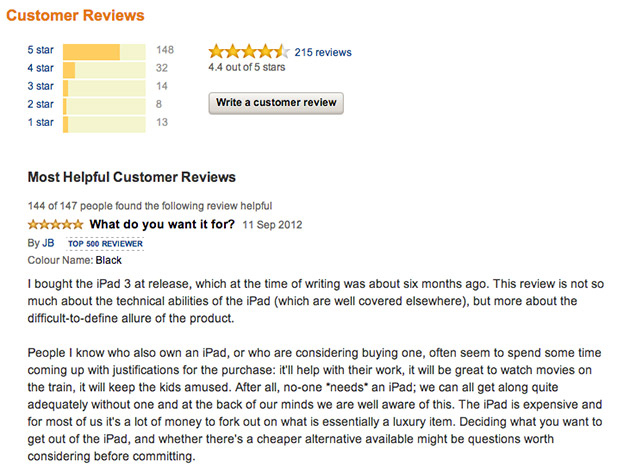How to Use Social Proof to Increase Conversions on Your Website
In The Art of Online Deception, I explored the darker side of online persuasion, the techniques described in the article are highly unethical and you should avoid using them. However, there are other, positive design patterns that you can use to persuade your users to make decisions.
These patterns will increase your conversion rate and drive profit, but they can also compliment the user experience by helping your users make decisions.
This article explores social proof and how our ingrained psychological need for belonging can be used to encourage user decisions, the pattern does exploit some knowledge of psychology and relies on suggestion but there is no trickery involved. Social validation is welcomed by users to assist them in making difficult decisions that involve many choices.
What Is Social Proof?
Humans are social beings – we each carry an innate and unshakable need to belong. Most of our behaviours, beliefs and attitudes are derived from our observation of others, many of these are subconscious responses that we have learnt over time, allowing us to automatically handle common everyday situations. For example, we don’t have to consciously think about how to use a knife and fork – this is a learnt behaviour that we acquired in childhood through the observation of our parents.
What happens when we are faced with an unfamiliar situation?
The first thing we do is look to others to determine how we should behave. This increases the likelihood of making the correct choice - if everyone else is doing it, then it must be OK for me to do it too. Social proof then, is simply looking to other people to determine how we should behave. The larger the group of people we take influence from, the stronger the effect of the validation.
We rely on social proof for handling many of life’s unfamiliar situations; on your first day at a new job – you will consciously watch others in order to familiarise yourself with the company’s routines and unspoken social conduct. At a posh dinner party you look to others to determine the appropriate etiquette.
The Bystander Effect - The Dark Side of Social Proof
In most scenarios, social validation is a useful tool for allowing us to effectively deal with unfamiliar situations, but it can also paralyse us from taking any action at all. In The Tipping Point, Malcolm Gladwell talks about the curious murder of Kitty Genovese.
One of the most infamous incidents in New York City history, for example, was the 1964 stabbing of Kitty Genovese. Genovese was chased by her assailant and attacked three times on the street, over the course of half an hour, as thirty-eight of her neighbours watched from their windows. During that time however, none of the thirty-eight witnesses called the police.
Malcolm Gladwell, The Tipping Point
Why did no-one help this woman? Are humans that apathetic? In such a traumatic situation, the neighbours lacked the awareness of an appropriate response and looked to the other neighbours to determine what action they should take, unfortunately no-one was taking any action. This may seem irrational or illogical, but our desire for acceptance and to belong is deep rooted within our psyche and the effects it has on our behaviour cannot be underestimated.
Another reason noone intervened in the murder; being part of the crowd also absolves us from individual responsibility, Derren Brown produced a programme based on this effect – ‘The Gameshow’ featured an audience who were responsible for making a series of decisions that determined the fate of one individual who was being secretly filmed. Throughout the show the result of these decisions became increasingly more dramatic, from drink spilt being on his shirt to a climatic incident in which he was struck by a moving car.
Of course, it was a setup – the individual was really an actor and the audience were the experiment; but it proved how far the individuals were prepared to go while operating as part of a crowd, many individuals would never have sanctioned such terrible afflictions on another human being, however when part of a group, blame is dissolved and if everyone else is doing it – then it must be acceptable.
Social Proof and Commerce
Persuasion has been a powerful force in commerce since the beginning of time, from pushy salesmen to subliminal advertising techniques. Social proof techniques can be used to influence a customers decision when choosing a product or service, for example, the restaurant with the longest queue is perceived to be superior because more people have chosen to dine there. Many nightclubs manipulate this principle by restricting entrance to customers in order to maintain a large queue outside, giving the impression the club is busy when in many instances there is actually no-one inside.
A donation jar should always have some money placed within it to suggest that other people have made a donation, failing to do so may give the impression that other people are not donating – so you must not donate either. Certain television programmes even employ professional audience members to cheer, laugh or behave in certain ways – in order to influence the behaviour of the real audience, a classic and cliché example of this is canned laugher.
iPhone5 Launch or Glastonbury?

Why do thousands of customers queue outside the Apple store, sometimes for days in order to purchase the latest iPhone on the day of its release? It certainly isn’t because they have a deep, ingrained need for the new functions of the phone.
This is a powerful example of social proof at work, queueing up like this in most peoples minds is irrational, a waste of time and perhaps even a little crazy. If you were to camp outside your local supermarket overnight on your own you would most likely receive some strange looks from passers by. However, if everyone else is doing it, then it’s totally acceptable.
If everyone else is getting the new iPhone, then you must have it as well in order to fit in and be accepted. If everyone else is queueing for days in the rain in order to get it, then you should do this too. Follow the herd and you can’t go wrong.
Social Proof and eCommerce
Just because the web doesn’t have pushy salesmen in your face or long queues of customers, it doesn’t mean that it is void of persuasive techniques, social proof can be used just as effectively online, not just to persuade people to make a purchase, but also what to purchase.
With so much choice available, it can be easy for users to become paralysed – social proof allows the user to look to others to determine what action should be taken, it also absolves them of individual responsibility to a degree and provides reassurance that if other people made this choice successfully, then it must be the right decision.
Let’s look at some examples.
Testimonials
This is one of the most common forms of social proof in commerce, it allows the user to validate their choice based on the experiences of others who are already using the product or service.

Shopify include customer testimonials on their homepage – these particular customers are well known members of their respective industries, which helps to strengthen the validation; testimonials from people we know or respect carry more weight than those from people who are unknown to us. This principle is commonly found in traditional advertising when celebrities are seen to be using a particular product – if it’s good enough for them, then it’s certainly good enough for the rest of us.

Basecamp combine statistics with customer testimonials, statistics appeal to our sense of logic and make us feel as though we are making an informed decision based on facts.
The second statistic on this page is ambiguous – 97% of which customers? Basecamp’s customers? Customers within that market segment? Can this claim be backed up with figures?
The downside to customer testimonials is these feelings of doubt, because the testimonials are selected by the company selling the product, they will only show the product in a positive light, which can appear to be too good to be true.
Recommendations
Amazon are the king of social proof, they use various techniques throughout the site, often in excess at times. Each individual product page has multiple sections that inform the user of the decisions other customers have made.

Here we have two different sections which ultimately do the same thing; attempt to convince you to make an additional purchase because other people have done it. The Frequently Bought Together section suggests additional items that you may be interested in because other people were; there is a clear call to action at this point, ensuring it’s easy to confirm this decision.
The next section – Customers Who Bought this Item Also Bought is virtually the same, having refused the previous suggestion Amazon are trying once again to tempt you with some additional products that other people, just like you, purchased.

Further down the page, there are more suggestions based on what other customers have done – this time appealing to the fact that you might not actually purchase this item, Amazon suggest some alternative items that you could view instead.

Recommendations may also come in the form of Best Sellers, as seen on the Waterstones website – which recommends a list of the most popular books based on what other people have purchased.

They also include a section on their homepage entitled Books in the news and media – suggesting that these books are generating a lot of conversation, if other people are talking about them so much then they must be worth reading.
Ratings
Ratings can be found in a range of online contexts and provide a lot of value for users, they not only help with buying decisions on eCommerce websites but prove to be invaluable on services like Netflix when making a decision that includes hundreds or thousands of choices.

In addition to providing a Popular on Netflix section that informs you of what most other people are watching – Netflix also provide a rating system in which each individual film is given a star rating out of 5, based on the average rating selected by other members. This is very powerful – do you watch the film with only 1 star, or the one with 4 out of 5 stars? If everyone else thought it was good, then it must be worth watching.

Rdio, the online music streaming service apply a similar technique; they provide statistics for each song; how many people have listened to it, how many playlists it appears on and how many of your friends have listened to it. They also provide user reviews for each track.
Reviews
Reviews are much more effective and less bias than testimonials – they are commonly found on eCommerce sites or on independent review sites. Rotten Tomatoes provides movie reviews, written by both critics and consumers.

Amazon add to their social proof arsenal with a powerful review system, this is an open and honest platform for customers to write about their own experiences with products they have purchased. Reviews can either contribute towards a sale, or be hugely detrimental to a brands reputation. The review system is combined with a rating system, allowing customers to quickly gauge the general opinion of others on a particular product.
Interestingly, each customer review also has its own rating – ’144 of 147 people found the following review helpful’ – the review validates the product and the rating system then validates the opinion. This is a powerful technique, accepting an individual’s opinion on something is extremely unpredictable, validating the review like this transforms a single opinion into the shared opinion of 144 other people.
Who Else is Going?
At Get Invited, we use attendee lists on event registration pages to show who else is attending a specific event.

This is a great technique for driving people to a particular event, if people see that many other people are attending, including their friends – they will feel compelled to attend themselves.
Social Proof and Search Engines
The power of social proof has been recognised by some major search engines and now has an influence on how pages are ranked. Traditionally a web page is ranked based on how trustworthy it is, which is calculated based on the number of other pages that link to it and the weighting of those pages - similarly, the weight of these other pages is calculated by the number of pages linking to them.
The amount of links on social networking sites to your own site could now have a major impact on your search ranking, as with page weighting, individuals can also be weighted by the search engines:
Do you calculate whether a link should carry more weight depending on the person who tweets it?
Bing: Yes
Google: Yes we do use this as a signal, especially in the “Top links” section [of Google Realtime Search]. Author authority is independent of PageRank, but it is currently only used in limited situations in ordinary web search.
Danny Sillivan - What Social Signals do Google and Bing really count?
This is the missing human component of search engine algorithms that has previously been impossible without the intervention of real human beings.
Conclusion
Although some of the techniques described can seem a little forceful – such as Amazon’s multiple *Customers also bought *sections, in nearly all circumstances social proof can add value to the user experience by helping people make difficult decisions. With so many products and services available – the choice can be perplexing, so ratings, reviews and recommendations can really help in the decision making process.
In comparison to dark patterns, these techniques are not deceitful or dishonest – providing the reviews or testimonials are not fabricated by the companies selling the products. Users are always aware of these features and are always in control of their own decisions – even if there is a degree of persuasion, it’s not manipulative.
References
Adam Rightor - Social Validation: A Powerful Online Decision-Making Influence
Ben Parr - Likes, Retweets, Comments & the Rise of the Validation Society
Susan Weinshenk - Social Validation: How Web Visitors are Influenced by Others
Susan Weinshenk – Neuro Web Design
Amina AlTai - The Power of Social Validation in Web Design
Westside Toastmasters - The Rule of Social Validation
Danny Sullivan - What Social Signals Do Google & Bing Really Count?